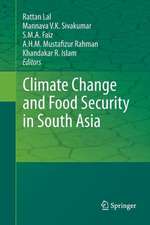Carbon Sequestration in Soils of Latin America
Editat de Rattan Lal, Carlos Cerrien Limba Engleză Hardback – 5 iul 2006
The problem of quickly mounting CO2 emissions in the fast-developing Latin American region was addressed in a symposium held in Piracicaba, Brazil, in June 2004. Carbon Sequestration in Soils of Latin America presents the latest available knowledge in soil C sequestration and improved land and soil management which can also lead to other positive effects, such as greater fertility of soil and higher crop yields. This text, in easy-to-understand language, comprehensively reviews ways to best transform various soils from being a source of carbon released into the atmosphere to become a sink for carbon absorption.
Carbon Sequestration in Soils of Latin America presents a full-rounded explanation of this information in four sections. The first section gives detailed background information about the region, its climate, and the differing soils, along with basic concepts behind the science. The second section describes recommended management practices and rates of soil C sequestration. The third section thoroughly deals with methods of assessment of soil C. The last section provides a summary of recommendations for further research and development. The book is extensively referenced and contains numerous figures, tables, and photographs.
Topics in Carbon Sequestration in Soils of Latin America include:
- soil eco-regions and principal biomes of Latin America
- soil carbon stock in principal ecosystems of Latin America
- rates of carbon sequestration in different eco-regions for predominant land use and management
- the role of the Amazon region in mitigating climate change
- the importance of tropical savannas of Latin America in mitigating global warming
- innovative methods of assessment of soil carbon pool
- trading carbon credits
- designing pilot soil carbon sequestration projects
- potential of soil carbon sequestration in Latin America
- priorities and recommendations for future research
Preț: 1053.57 lei
Preț vechi: 1448.34 lei
-27% Nou
Puncte Express: 1580
Preț estimativ în valută:
201.60€ • 210.48$ • 166.85£
201.60€ • 210.48$ • 166.85£
Carte tipărită la comandă
Livrare economică 05-19 aprilie
Preluare comenzi: 021 569.72.76
Specificații
ISBN-13: 9781560221364
ISBN-10: 1560221364
Pagini: 584
Dimensiuni: 152 x 229 x 42 mm
Greutate: 1.07 kg
Ediția:1
Editura: CRC Press
Colecția CRC Press
ISBN-10: 1560221364
Pagini: 584
Dimensiuni: 152 x 229 x 42 mm
Greutate: 1.07 kg
Ediția:1
Editura: CRC Press
Colecția CRC Press
Public țintă
ProfessionalCuprins
Preface PART I. PHYSIOGRAPHY AND BACKGROUND Chapter 1. Soil Ecoregions in Latin America; Introduction Continental Parameters The Biophysical or Natural Environment Soil Regions in Latin America Conclusion Chapter 2. Challenges and Opportunities of Soil Carbon Sequestration in Latin America; Introduction Soil Carbon Stock Estimation Under Native Vegetation Changes of Soil Carbon Stocks upon Land-Use Change Final Considerations and Conclusions Chapter 3. Soil Carbon Sequestration in Latin America; Introduction Terrestrial Carbon Pool Soil Carbon Sequestration Soil Carbon Sink Capacity Rate of Soil Organic Carbon Sequestration Opportunities of Soil Carbon Sequestration in Latin America Conclusions Chapter 4. Soil Carbon Stocks in Soil Ecoregions of Latin America; Introduction Present Land Use and Estimates of Soil Carbon Stocks Impacted by Agricultural Activities Conclusion PART II. SOIL CARBON SEQUESTRATION IN DIFFERENT BIOMES OF LATIN AMERICA Chapter 5. Soil Carbon Sequestration in Western Mountain Ridges and Deserts of South America; Introduction General Characteristics of Biome B by Country Land Use and Land-Use Change in Biome B Soil Degradation in Biome B Soil Carbon Storage in Biome B Conclusions Chapter 6. Carbon Sequestration in Soils of the Western Mountain Ridges and Deserts of Argentina Chapter 7. Soil Carbon Sequestration in Mexico and Central America (Biome A) Chapter 8. Potential of Soil Carbon Sequestrationin Costa Rica Chapter 9. Above- and Belowground Carbon Sequestration Under Various Land-Use Systems and Soil Types in Costa Rica Chapter 10. Soil Organic Carbon Sequestration in the Caribbean Chapter 11. Carbon Sequestration Potential of the Neotropical Savannas of Colombia and Venezuela Chapter 12. Potential of Soil Carbon Sequestration in the Amazonian Tropical Rainforests Chapter 13. Carbon Sequestration Potential of Pasture and Agro-Silvo-Pastoral Systems in Tropical Andean Hillsides Chapter 14. Soil Carbon Storage and Sequestration Potential in the Cerrado Region of Brazil …Part Contents…PART III SOIL CARBON ASSESSMENT METHODS
Notă biografică
Rattan Lal, PhD, is a professor of soil physics in the School of Natural Resources and director of the Carbon Management and Sequestration Center, FAES/OARDC at Ohio State University.Carlos C. Cerri, PhD, is a professor at the Centro de Energia Nuclear na Agricultura of the Universidade de São Paulo, Brazil, where he teaches graduate students and performs research on soil carbon sequestration and trace gas mitigation on tropical conditions. Martial Bernoux, PhD, is research soil scientist at the French Institut de Recherche pour le Développement (IRD) since 1999, now member of research unit “Soil carbon sequestration and soil bio-functioning.” Jorge Etchevers, PhD, is a professor of soil science at the Colegio de Postgraduados, Mexico, and a permanent visiting professor of the Universidad of Concepción, Chile. Eduardo Cerri, PhD, is a post-doc at the Centro de Energia Nuclear na Agricultura (CENA-USP), Brazil. In 2003 he received his PhD in soil science from the University of Sao Paulo.
Descriere
The problem of quickly mounting CO2 emissions in the fast-developing Latin American region was addressed in a symposium held in Piracicaba, Brazil, in June 2004. Carbon Sequestration in Soils of Latin America presents the latest available knowledge in soil C sequestration and improved land and soil management which can also lead to other positive effects, such as greater fertility of soil and higher crop yields. This text, in easy-to-understand language, comprehensively reviews ways to best transform various soils from being a source of carbon released into the atmosphere to become a sink for carbon absorption.


















